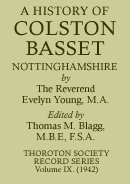< Previous | Contents | Next >
Chapter VI.
1842 and after
The Tithe Award, drawn up in 1842, with its map, affords material for a comparison both with former and with present days.
In the preamble to the Award it is stated that the lands subject to tithe were:—
| Arable land | 1125ac. | 3r. | 12p. | |
| Meadow or pasture | 1213ac. | lr. | 15p. | |
| Woods and plantations | 54ac. |
These figures give a total area slightly in excess of that given in the actual award, but they serve to show the proportion of arable and grass land. The amount of land under cultivation appears to have been much larger than it was in 1683, when Sir Edward Golding owned more than 1400 acres of grass land and also larger than it is at the present day; but in 1842 it paid to grow corn. The latter half of the eighteenth century and the former half of the nineteenth give us a period of great agricultural prosperity, arid to this period undoubtedly belong the substantial houses and homesteads, which had sprung up away from the village. Such are the Church Hill farm (now the Estate Office), and Edmondthorpe Lodge on the west side of the Smite; and on the further side of the river and beyond the village the Hills Farm. Rose’s Farm and Colston Hills Farm. In 1600 there had been no outlying houses of any description. To the same period of prosperity belong some of the larger farmhouses in the village itself,—the “Martin’s Arms Inn,” the house opposite (this farm being known in Mr. Davy’s time as the River Farm), and that standing behind the new church (known at one time as the Colston Town Farm and bearing the date 1833 on one of the out-buildings). The smaller farmhouse close to Kay Wood must have been built since 1842. Since Mr. Knowles bought the estate six pairs of cottages have been built, all west of the Smite, several of these being much nearer to the old church than any house marked on the map of 1600.
There has been a tendency through the nineteenth century to make the estate a sporting property. Whereas in 1714 there were no woods, except what grows in hedgerows, in 1842 there were 54 acres of woods and plantations. Kay1 Wood, the Old Gorse and Winifred Wood are marked in the Award Map,
Though not by these names. Blanche’s Gorse has been planted since 1842, and there are numerous small spinneys and belts of wood—even the vicar’s glebe not being exempt. The names just given are well known in hunting circles. The parish is in two different hunts, the river Smite forming the boundary between the countries hunted by the Duke of Rutland’s (Belvoir) and the South Notts. packs; the centre of the village is one of the regular meets of the former.
The actual number of inhabited houses in 1842 was 64; a dozen or more of these have ceased to be habitable. At the present time the number is 70. In 1600 the number might have been about 50, but there was probably a decrease of population after this time, owing to the land being enclosed and much of it put down to grass. Mr Rose’s statement that there were 28 families in the parish in 1743, probably marks the lowest limit of population.
Two buildings of recent erection remain to be mentioned. One is the recreation-room standing close to the Market Cross, adapted from an army hut. The other is the Dairy, with manager’s house, belonging to the “Colston Bassett and District Dairy Ltd.” This was opened in 1915 and has specialized in the making of Stilton cheese and in obtaining a succession of high awards for this particular product at the principal shows from 1923 onwards, besides being a great help to the farmers of the neighbourhood. In 1930 at the annual snow of the British Dairy Farmers’ Association, London, first and second prizes were won together with the silver medal and cup presented by the Corporation of the City of London for the best exhibit.
Many of the lands described in the Tithe Award bear names, some of these, which do not occur on the map of 1600, seem to be worth mentioning. Three Canal Closes take their name from the Grantham and Nottingham Canal, made in 1793, which cuts off a small strip of the parish bordering on Owthorpe. The Hospital Closes are the property of the trustees of Frisby Hospital. Aldam’s2 Spring plantation, at the foot of the bill now known as Spring hill, refers to the spring of water in it. As is usual, names of former or present occupiers are recorded; e.g., Somner’s Honey butts, Basses Honey butts. Orson’s close, Crampton’s close, Milner’s pasture, Daft’s close and Atler’s close. Hunger hill, Starve’em and Pine’em seem to suggest unproductive soil. There are also the following names: Belle Vue, Reecy, Arbor close, Helen pasture, Frog close, Mar Syke, Little End, Penn end close, Gutterclose, Thick hill, New breach, Little nook, Sowtread and Young Ass.
< Previous | Contents | Next >
1. Probably named after Mrs. Kaye, who, it will be remembered, left the estate to Henry Murtin in 1802.
2. Possibly named after Marabell or Mirabel Aldham, wife of the first Edward Golding of Eye, Suffolk, steward to Sir Thomas Kitson of Rengrave Hall, from whom he bought Colston Bassett. T.M.B.
